Part 18: 2261-2270: The Stirrings of an Alien God
The Stirrings of an Alien God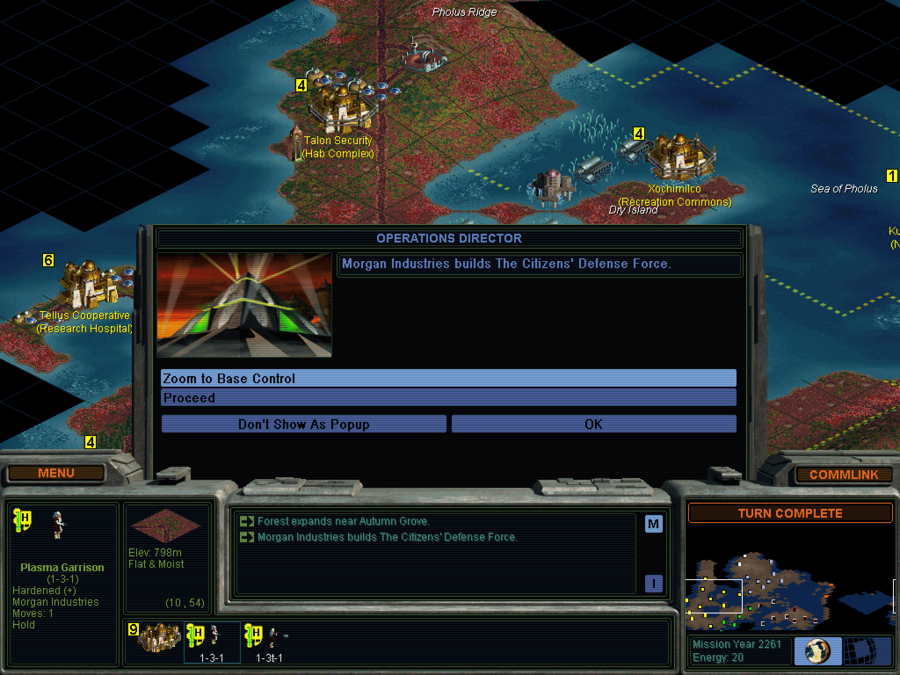

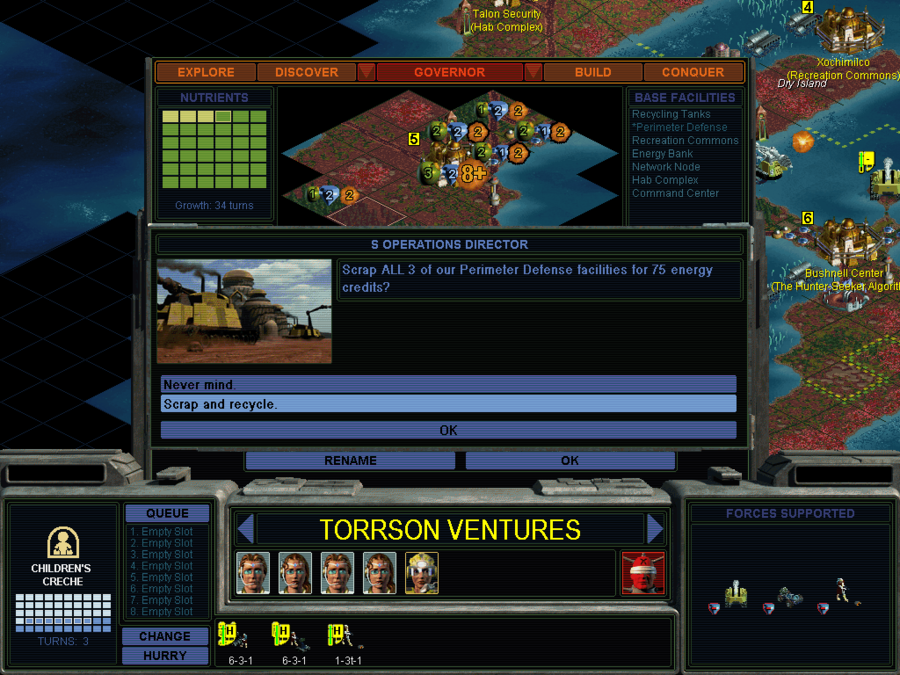
In 2261, the Citizens' Defense Force formally began operations, with civil defense plans and hardware for every settlement in North and South Pholus assembled, with corps of volunteers ready to back up professional soldiers to defend their settlements in the event of enemy action. Those settlements that already had defensive perimeters in place saved significant time and money for the CDF, as existing defensive arrangements were incorporated into the CDF's operations.
With Projects like the CDF that provide free facilities, you can scrap old instances of the facility for a little quick cash, so your earlier efforts are not entirely wasted. The video for the CDF, as usual recorded by somebody other than me: https://www.youtube.com/watch?v=2L5JgTkxAkg

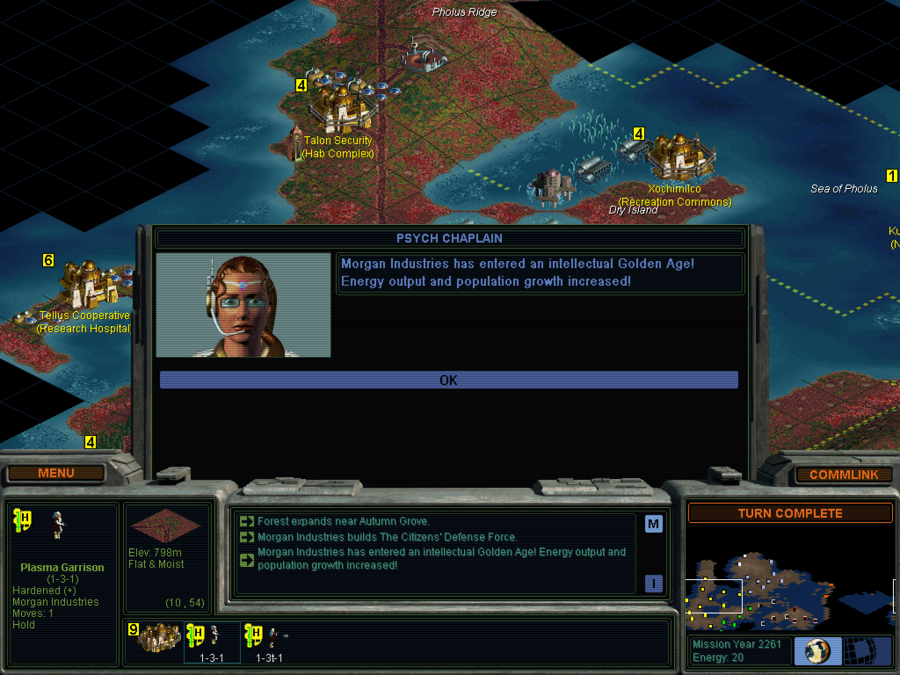
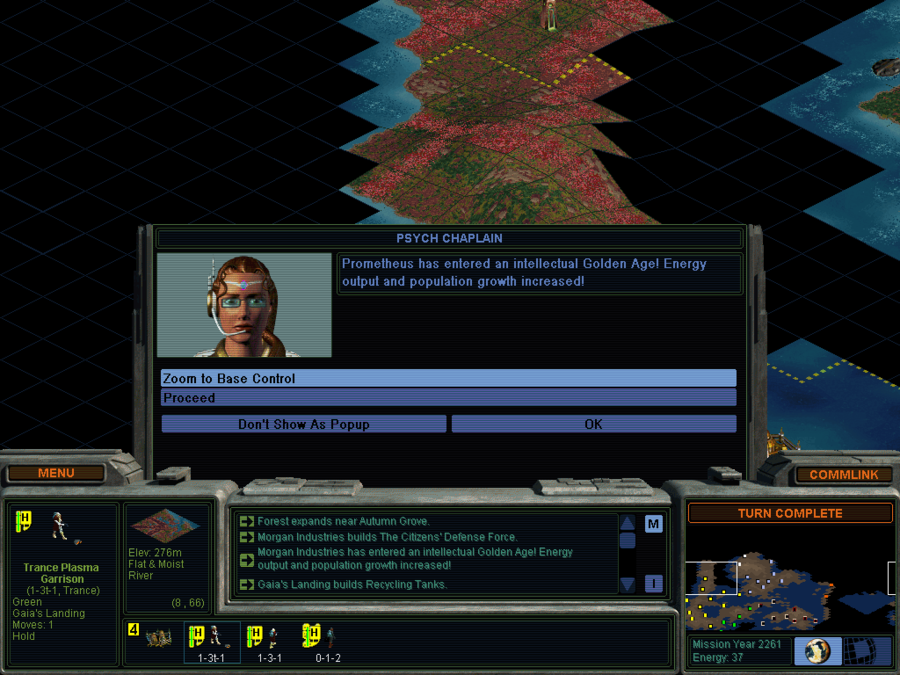
As the CDF went into operation, the economic development of North Pholus continued. Morgan emerged from its economic slump, while Prometheus enjoyed the benefits of its high productivity. Gaia's Landing set up organic reprocessing plants, helping supplement scarce resources.
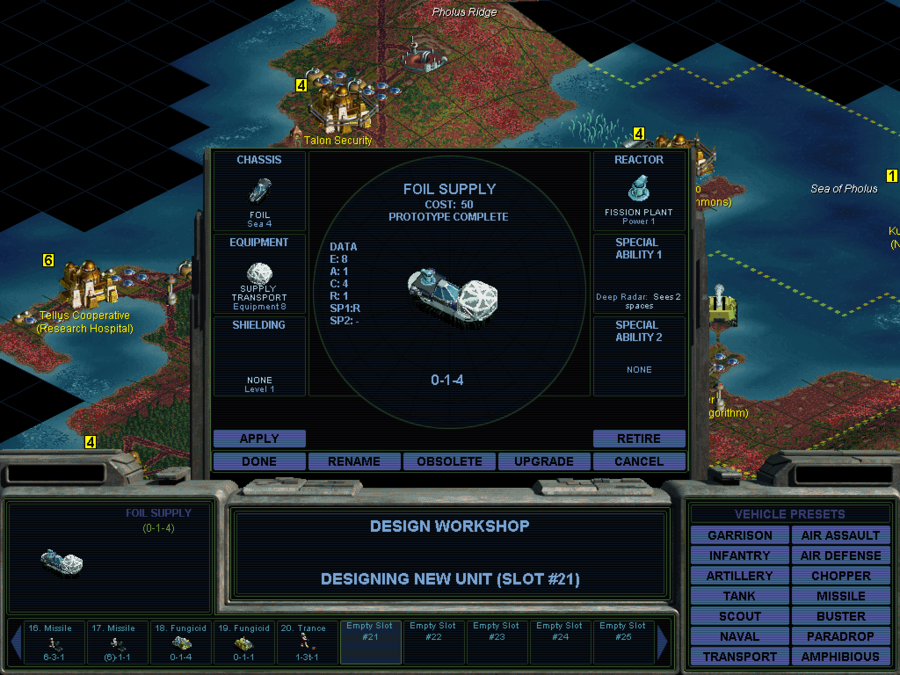
Work began in Morgan to assemble control systems, transport ships, and hardware for a major offshore geothermal plant with minimal human staff- the operation would be almost entirely automated, with only a few skilled technicians and administrators overseeing a robotic geothermal plant. Power was planned to be channeled to Morgan through a stretch of undersea cable, while supplies for the plant would be brought in by conventional shipping. This ambitious project marked a landmark in the industrial history of Chiron.
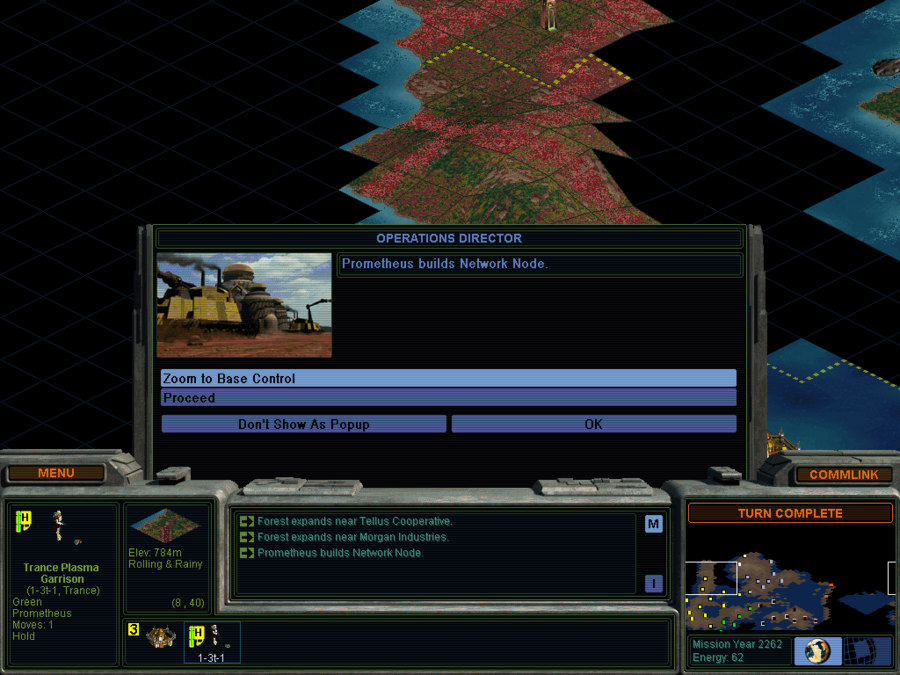
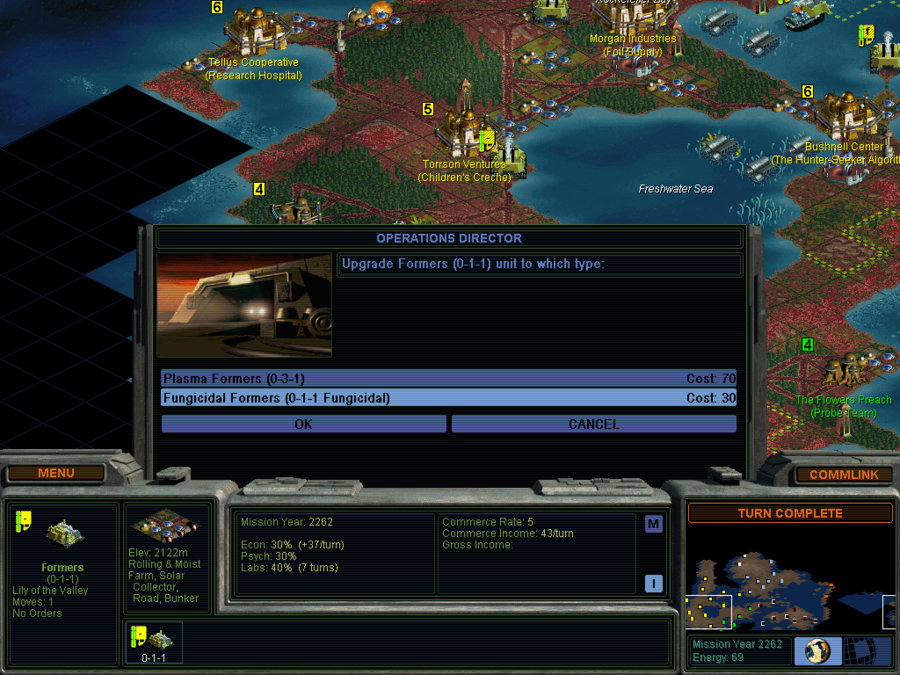
A year later, the settlement of Prometheus had been integrated fully into the North Pholan Datalinks, with network infrastructure and connection speeds matching anywhere else in the colony, while the first large-scale deployment of fungicides based on synthetic petroleum started amongst existing terraforming teams. By the end of the decade, almost every terraforming team in North and South Pholus would be making use of synthetic fungicides, helping clear fungal encroachments more efficiently.
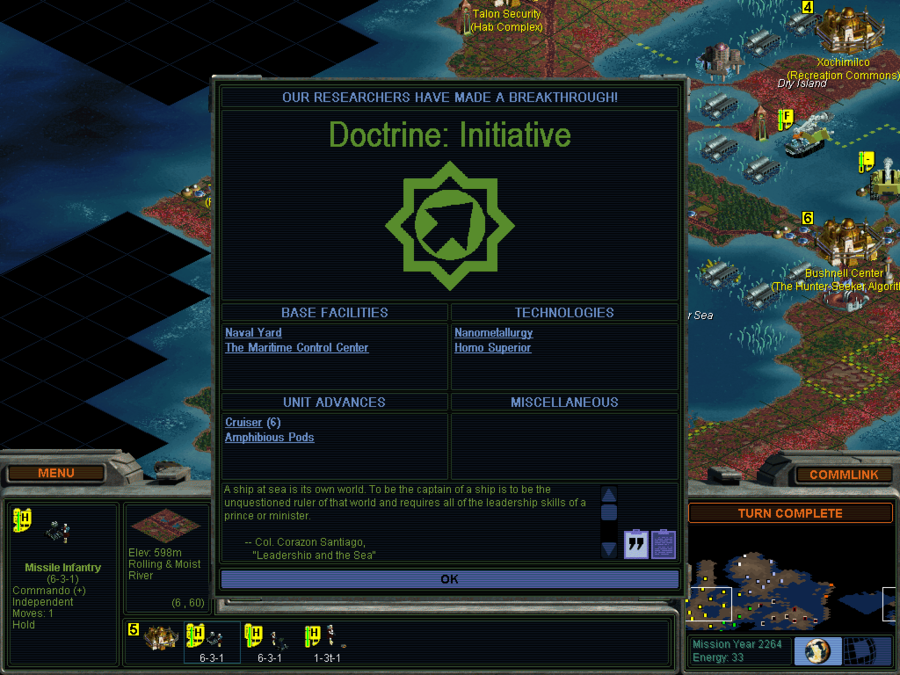
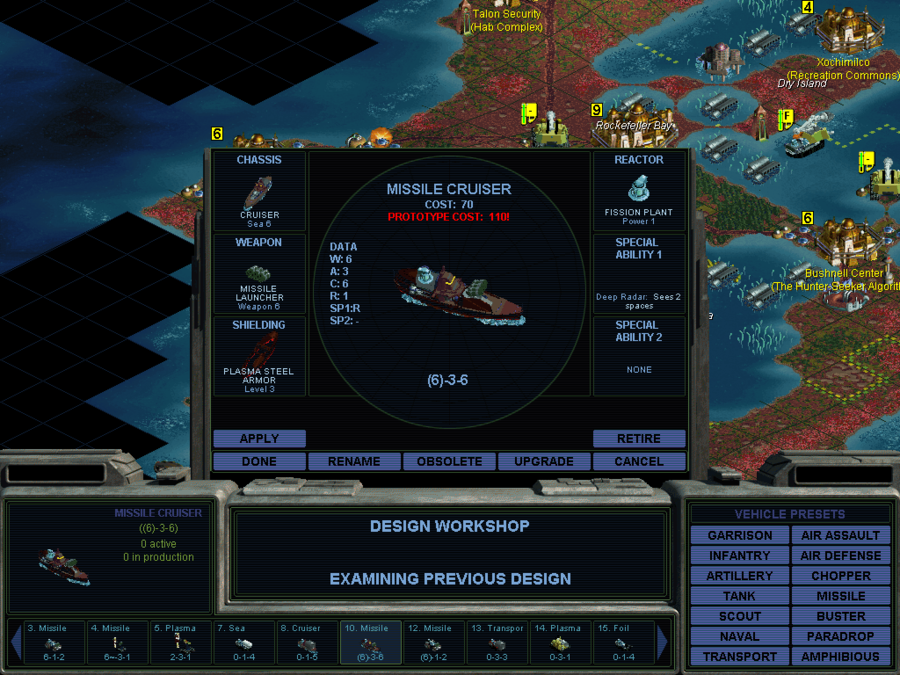
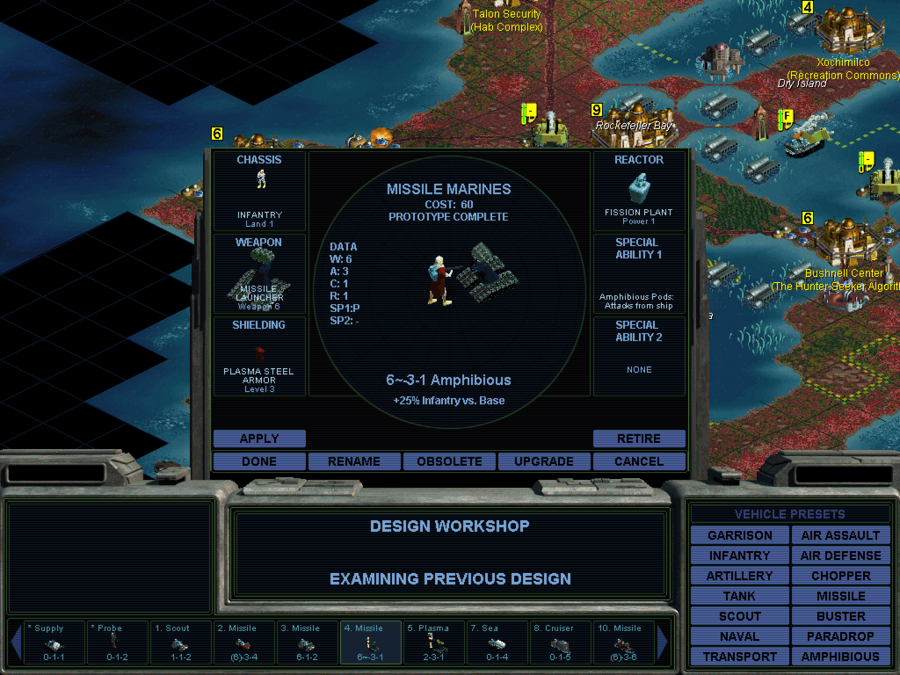
In 2264, the Tlaloc Initiative completed the necessary engineering, design, and infrastructural work to begin construction of North Pholus' first true heavy ocean-going ships, more seaworthy and with better cargo capacity than the older foil designs that the colony had relied upon. With the capacity to build heavy ships, the efficiency of overseas travel and transport was bound to be dramatically increased.
The new Cruiser chassis unlocks multiple new designs; I will spare you looking at all of them individually. Cruisers have higher strategic speed than Foils- presumably reflecting seaworthiness and easier logistics, rather than actual raw speed, as hydrofoils actually are an excellent way to increase the speed of boats in the real world- and transports on a Cruiser chassis have twice the capacity of Foil transports. Essentially Cruisers are a straight upgrade for ships. We also are able to outfit troops for amphibious assault now, although we don't have an urgent need for that yet.
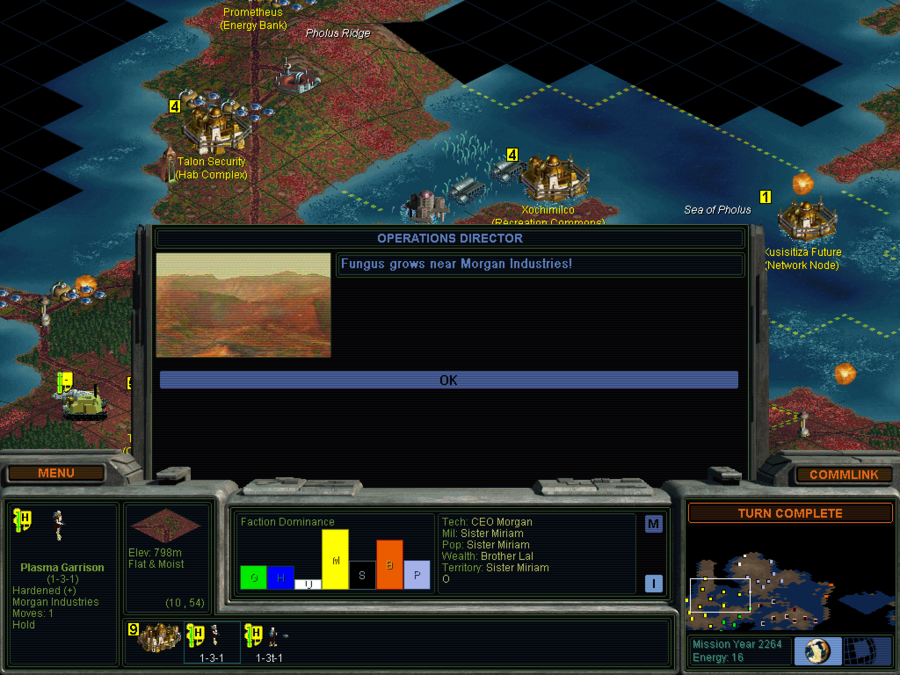


Meanwhile, the monolith complex on Dry Island suffered a sudden burst of fungal growth, the xenofungal forests to the north growing to engulf the complex in a single day. The monolith itself, thankfully, survived, although the event raised concerns throughout the colony. It was speculated that the sudden growth was a reaction to continual disruption of the xenofungus in the area. Beyond speculation was that xenofungal spore counts outside the xenofungal forests had been slightly but measurably dropping over time throughout the entire colony, slowly depressing fungal growth under ordinary conditions.
The basic outcome of continued eco-damage is fungal blooms such as the one we just experienced, which can be annoying and destructive, although continued blooms (and especially too many blooms following closely on each other) can eventually have more severe effects. Each bloom in our colony, however, reduces the capacity of the xenofungus to bloom again in our colony, slightly raising the safe cap for mineral production and terraforming- thus my reference to reduced spore counts. We can eventually get facilities that raise our colony-wide cap for pollution further, but right now our only way to raise the cap is to trigger new blooms.
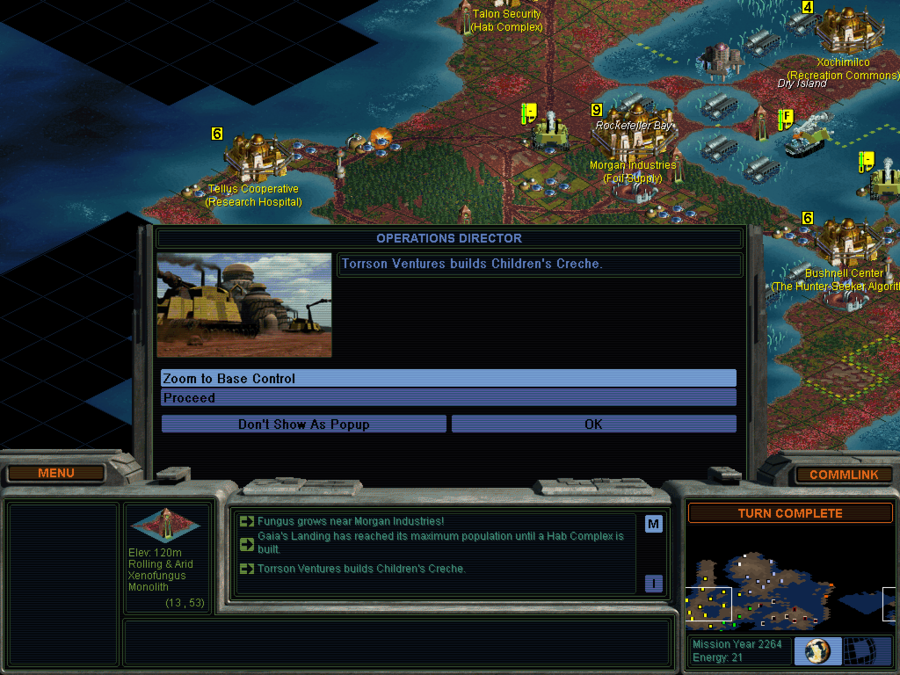
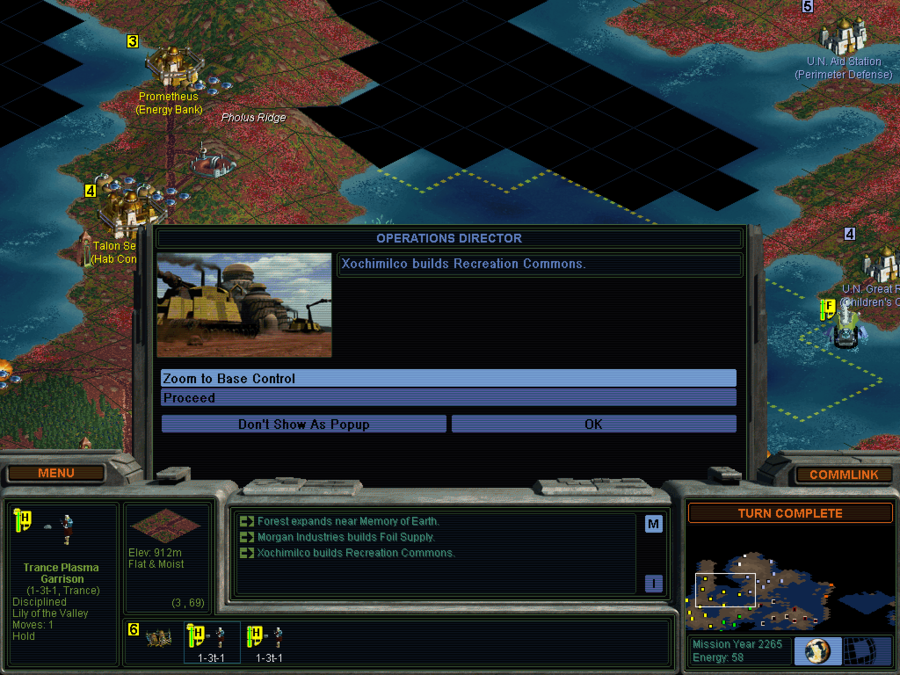
While Tlaloc pioneered new techniques and while the disaster on Dry Island was still fresh in the news, Torrson finished the process it had been undergoing of improving maternity health and early education for children. Little clinics and schools served the population, helping care for the needs of pregnant women and parents of young children. It grew easier than ever to establish a family in Torrson. A year later, in 2265, new small businesses, shopping districts, and sports facilities in Xochimilco provided opportunities for leisure, recreation, and employment in the settlement, slowly solidifying the excellent quality of life in North Pholus.
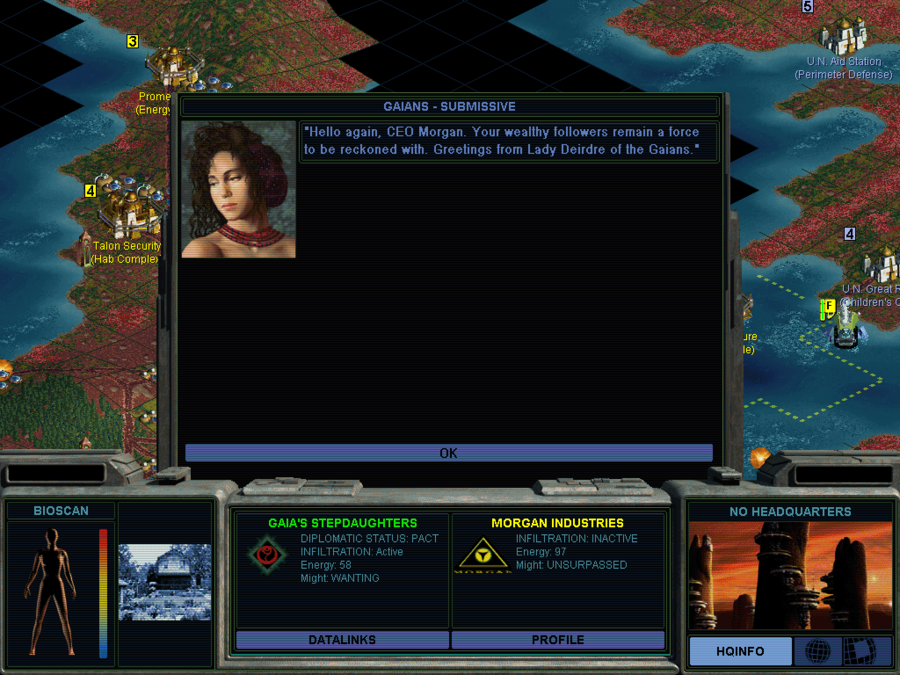
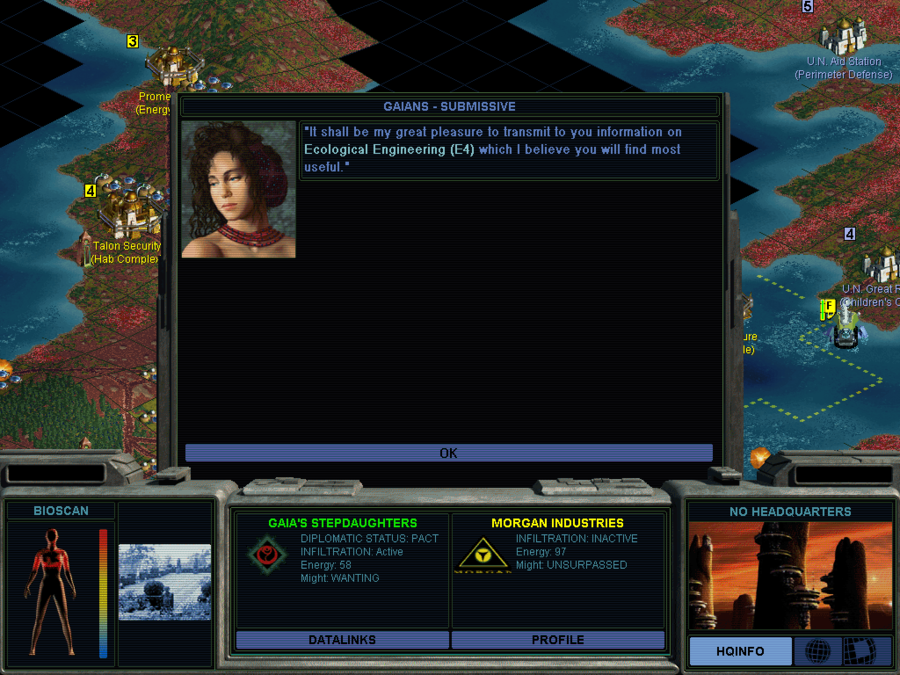
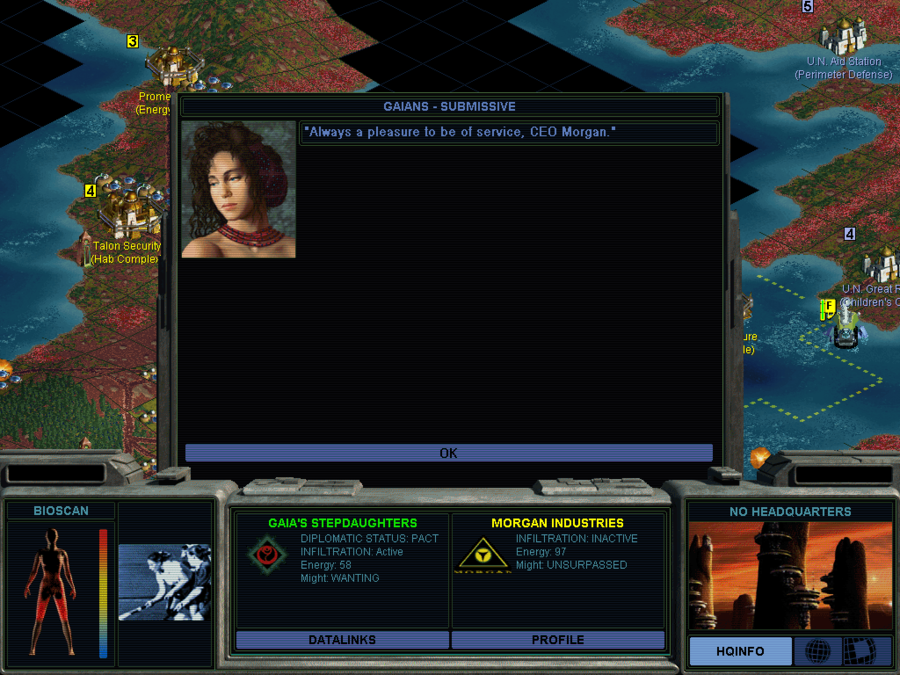
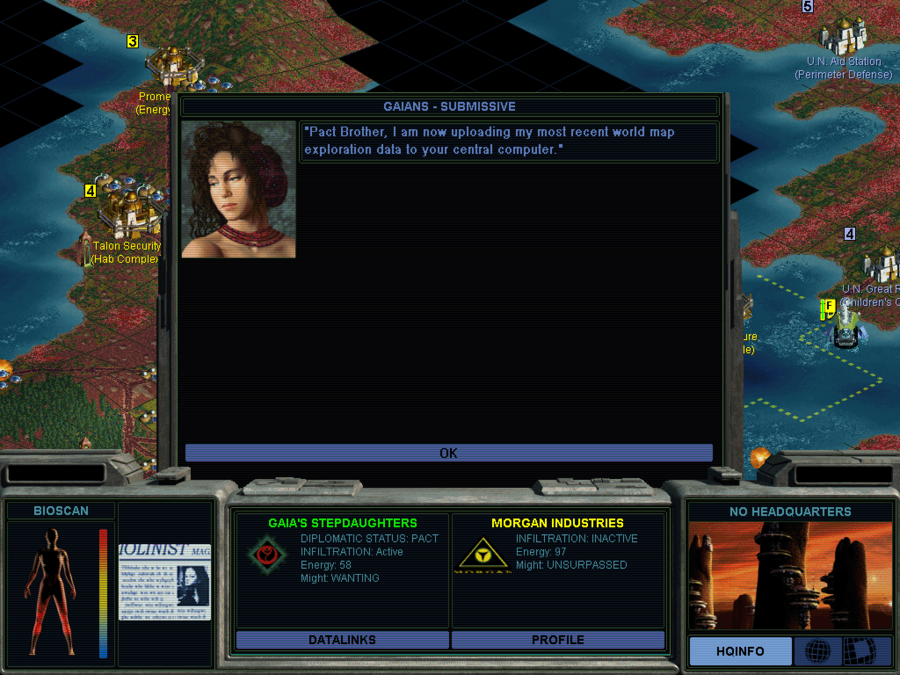

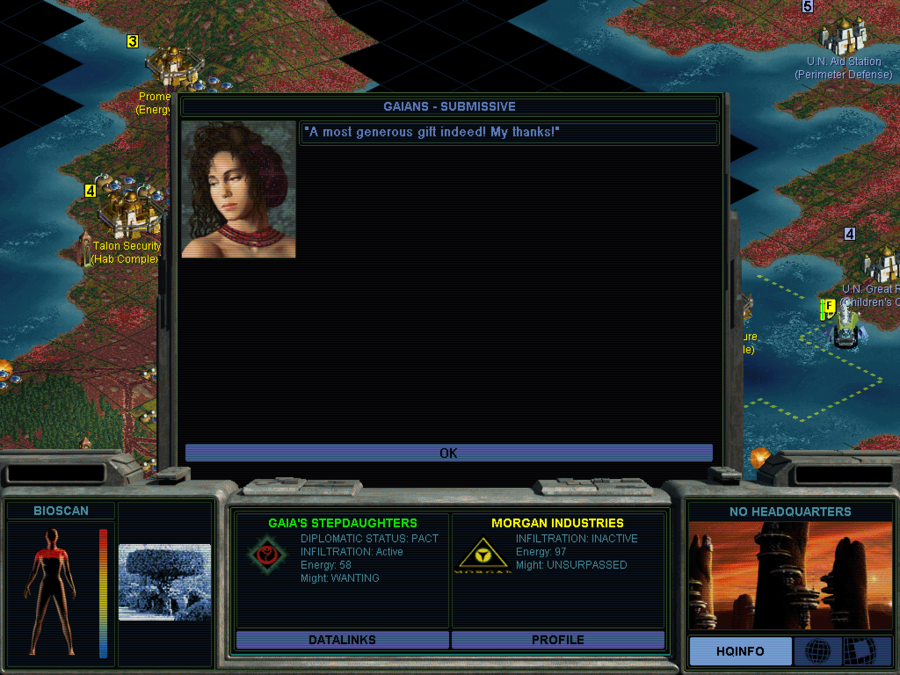
That same year of 2265, the North Pholan government, led by Colony Executive Leonard Sun of the North Pholus Commerce Party, held talks with the East Pholan government seeking tighter integration of the North Pholan and East Pholan economies. North Pholan firms exported technical expertise to East Pholus, while East Pholan breakthroughs in large-scale terraforming projects and mining methods were incorporated into the North Pholan economy.

New equipment, new methods, new designs, and a careful study of geology and meteorology should allow for engineering projects previously unthinkable. The boring of mines and geothermal plants to the edge of the mantle, the creation of artificial rivers, and more were now within the grasp of North Pholan engineers. Less dramatic, but still of value, is improvement of mining methods to allow for more profitable mining of scattered mineral deposits.
Ecological Engineering is just beautiful. It lifts the cap on minerals production in tiles without special resources, and unlocks a whole menu of wonderful new things you can build around your settlements.
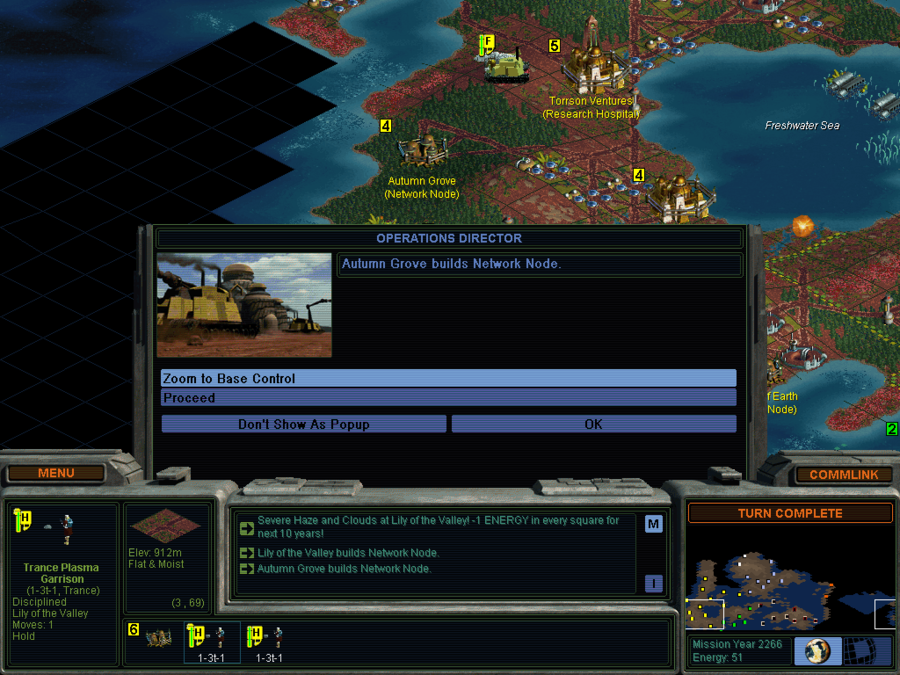
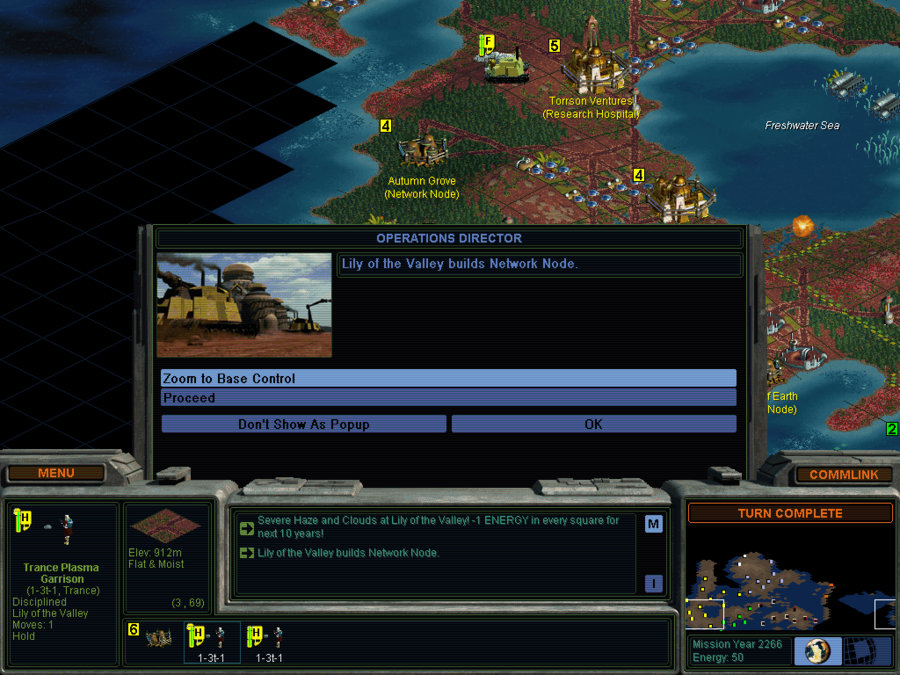
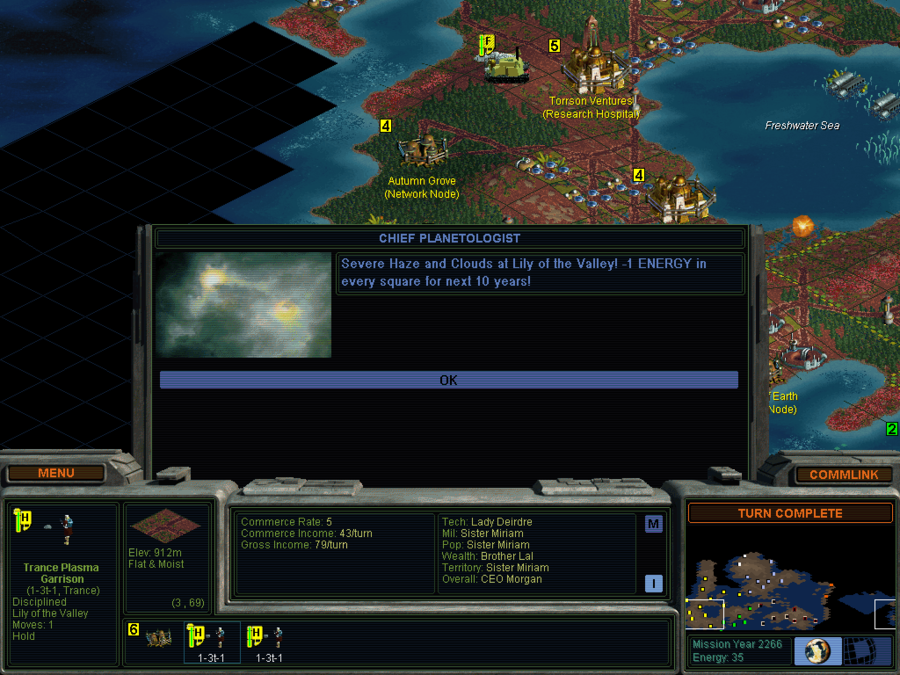
While network infrastructure was improved in South Pholus, Autumn Grove and Lily of the Valley being fully integrated into the North Pholus Datalinks by 2266, Lily of the Valley entered an economic slump. New terraforming methods provided new competition to the Ecological Study Institute, which has been a mainstay of the local economy. Although the settlement scrambled to adapt, it nonetheless struggled with changing conditions.
In keeping with my de-emphasis of solar due to the EROEI issues with solar, I'm re-interpreting the 'severe haze' random event as a good old-fashioned recession based on whatever economic conditions are logical at the time.
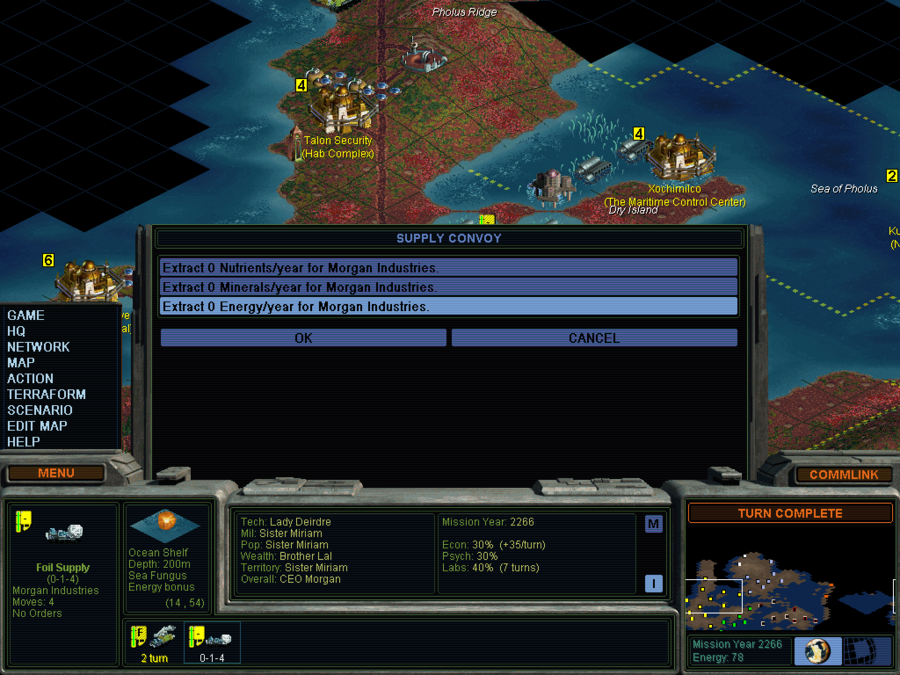
The cable and supply shipping for the new automated geothermal plant off Dry Island was ready by that same year, but the plant was yet to open- the xenofungus choking the area was yet to be cleared to allow construction.
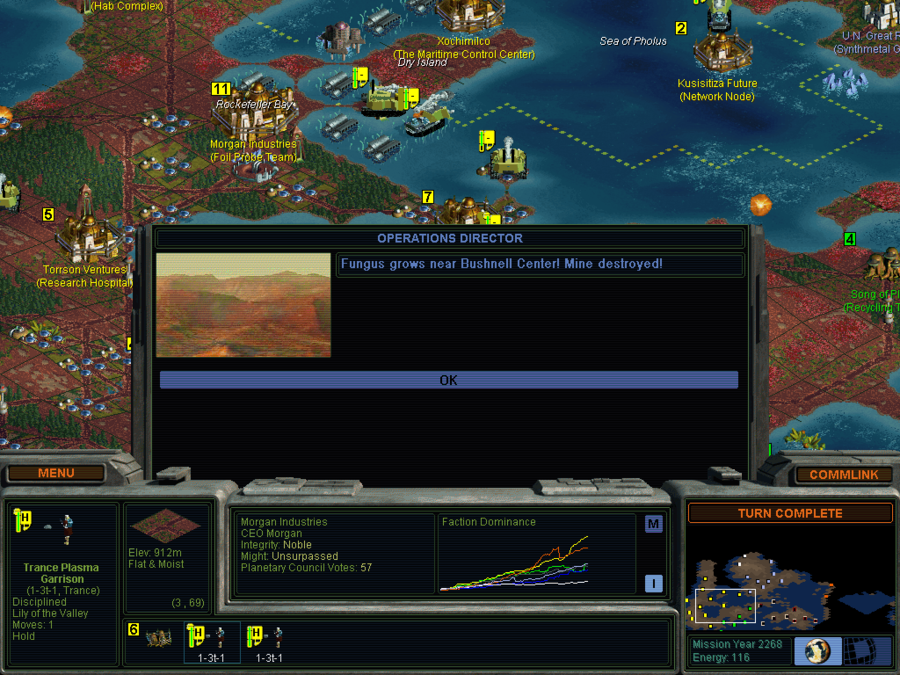
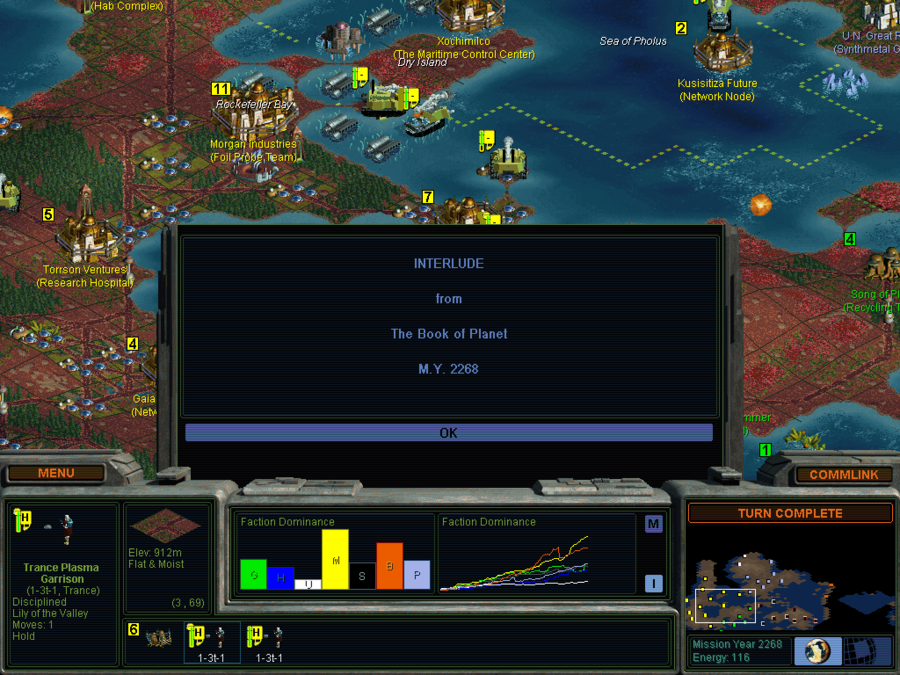

A second disaster with sudden xenofungal blooms broke out in 2268, the xenofungal forest to the east growing a new extension that ruined the major mining complex south of Bushnell Center. Shortly after the incident, Dr. Hal Kimberley, chief xenobiologist for Morgan Industries, issued a paper reporting on what appeared to be deliberate psionic contact by a 'voice' associated with the xenofungus with a human subject. The 'voice', based on the subject's self-report, seemed to be confused and hostile, issuing a threat about the upcoming bloom. The name of the human subject was stripped from the paper, preserving their anonymity. Still, spore counts continued to drop, and some xenobiologists estimated that there was little risk of a third bloom at the current time.
Meet the fungusmind, confused and incoherent as it is.
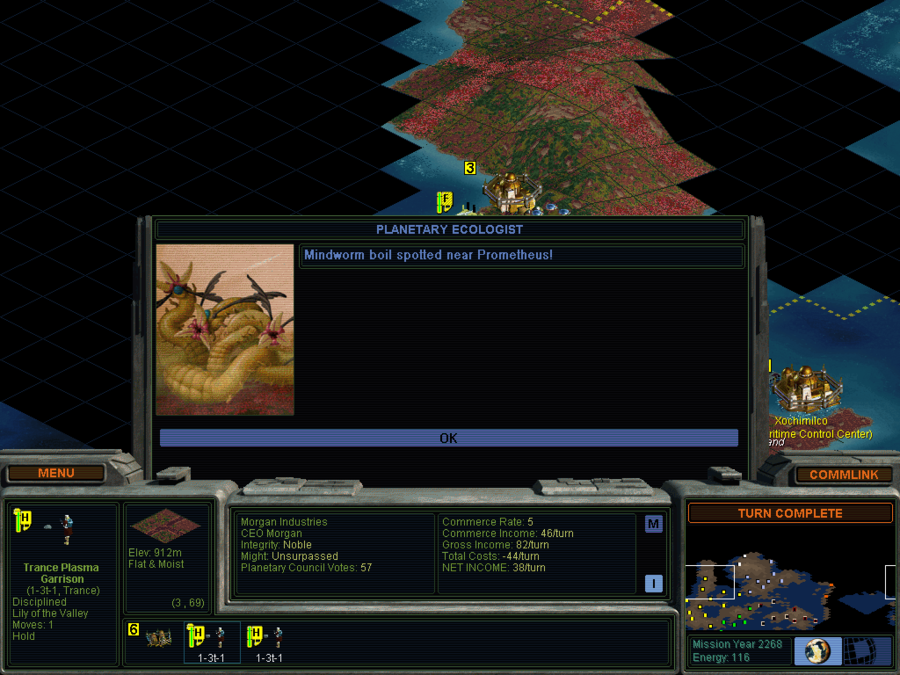
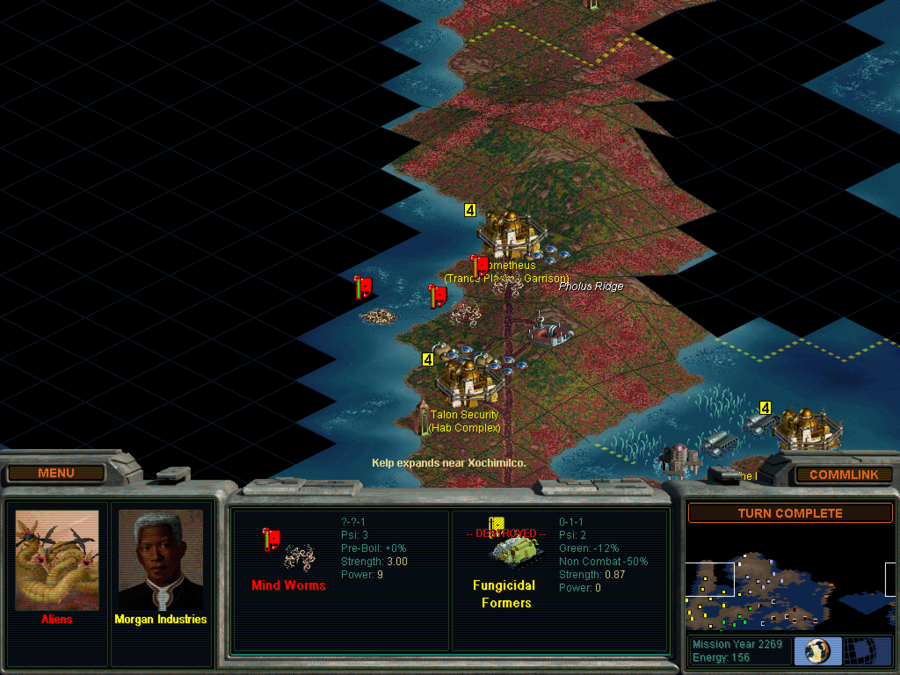
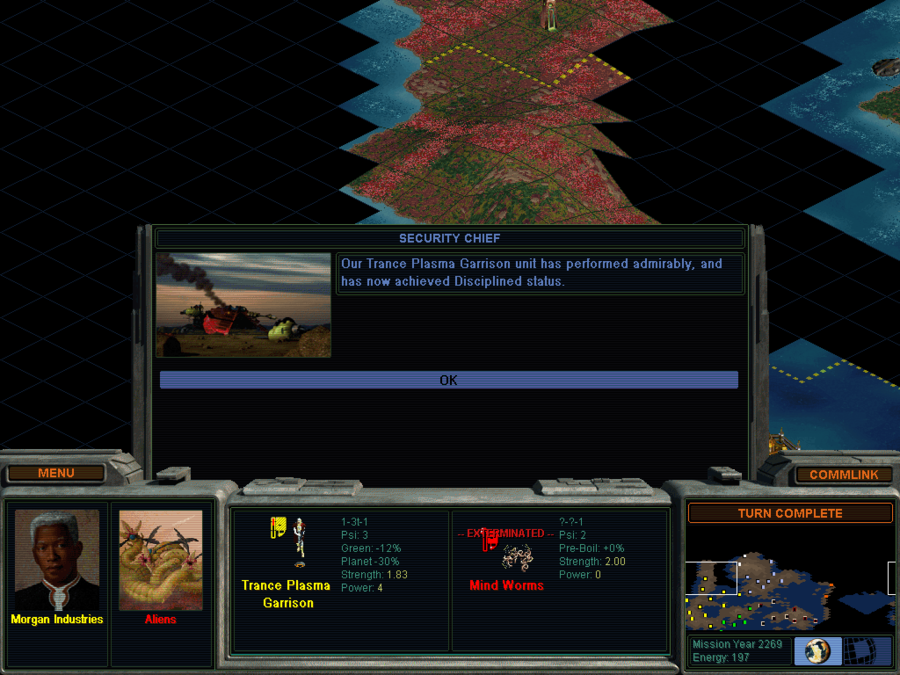
While this bloom was occurring, an aquatic swarm of mind worms made contact with the western coast of Pholus near Prometheus, overrunning terraforming teams working near Prometheus and inflicting heavy losses on Prometheus' local security when they attempted to launch a first strike against the worms. Although about half the worms were burnt out, the remaining swarm was still formidable, and Prometheus' defenses were badly weakened. Plans were made to send reinforcements up from Talon, hoping to relieve Prometheus.

By 2070, Western Coast Medical opened its own state of the art hospital facility in Tellus, the first true competitor in medical research to the Apollo Meditech hospital in Morgan. The continued improvements in medical research and techniques helped fuel a general improvement in research across the colony.
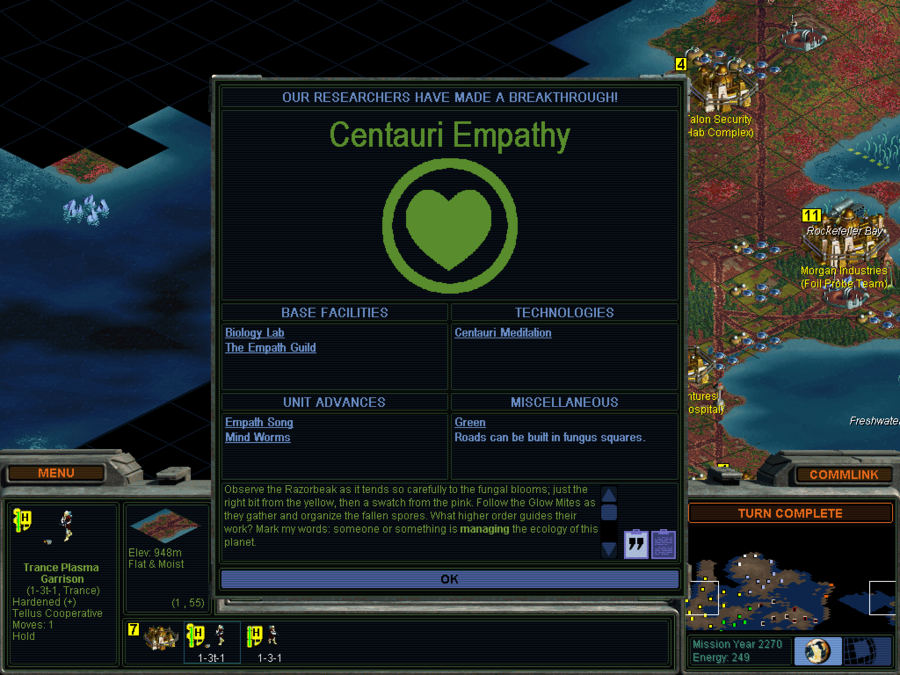
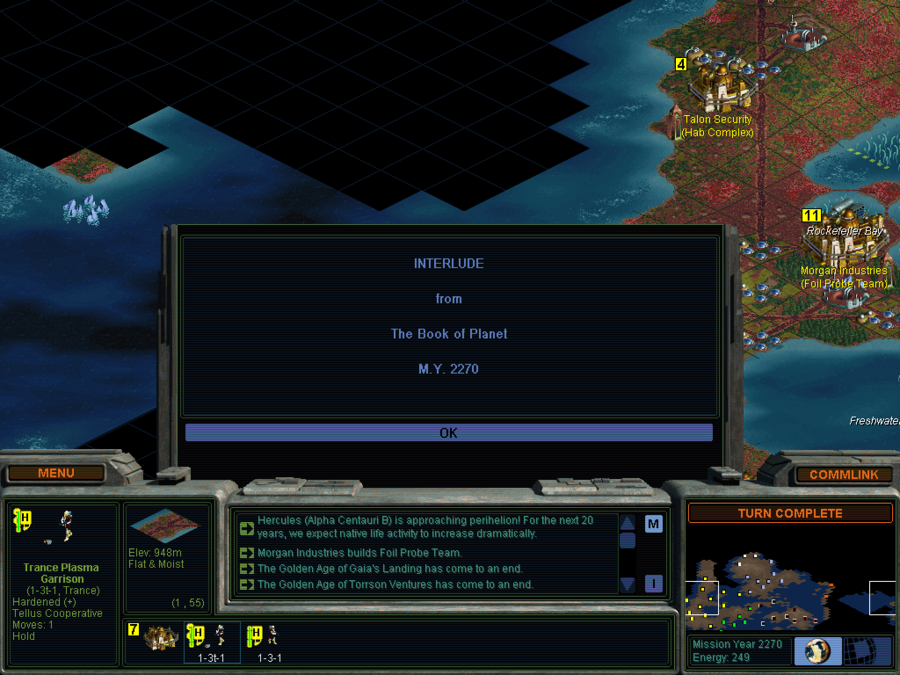

That same year, Dr. Kimberley finally achieved controlled breeding of mindworms in captivity, and the successful replication of Gaian control technology for mindworms. Headsets rebroadcasting radio communications based on human brainwaves provided a means for communication, and control- and tantalising hints of the potential of reading human brain states using similar technology opened themselves to researchers. Dr. Kimberley's ambition to achieve controlled breeding of mindworms before Dr. Skye was a success.
The Republic of North Pholus and Protectorate of South Pholus as of 2270
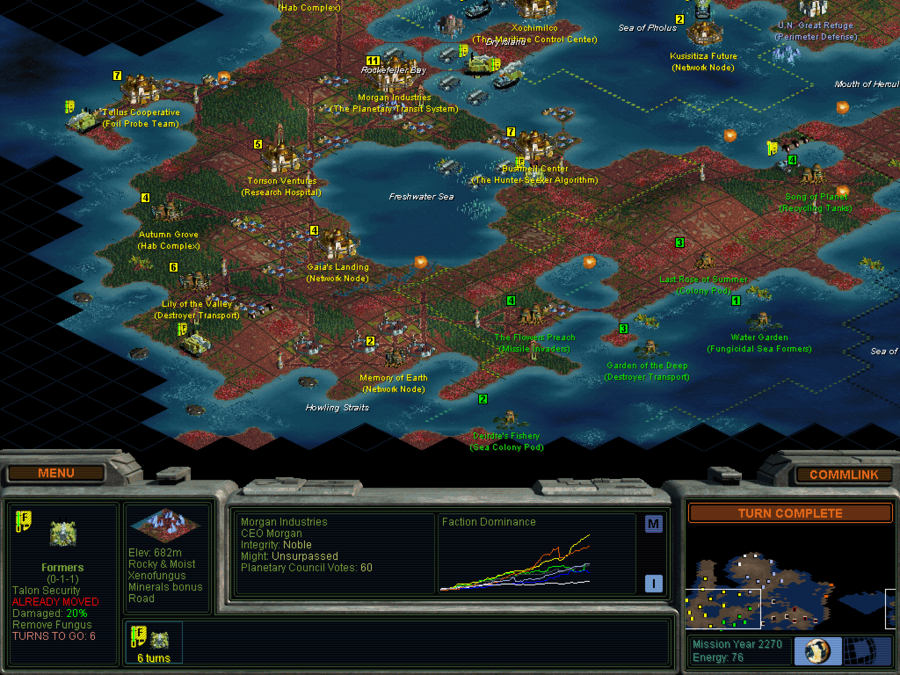
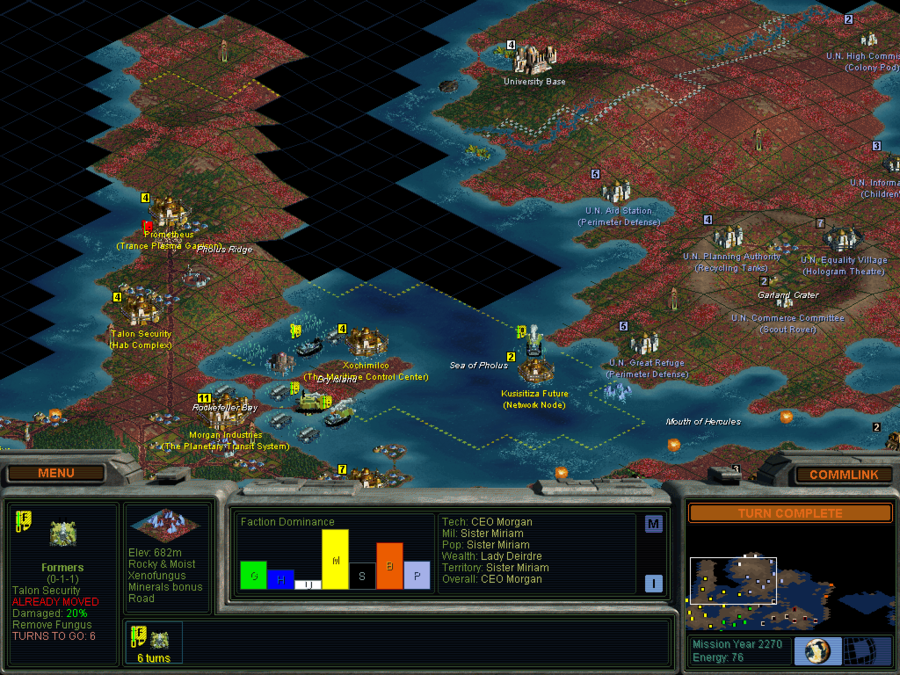
The fungal disaster on Dry Island has been cleaned up, while work on clearing the fungus from the mine south of Bushnell Center is under way. Elsewhere, the terran forests of North Pholus have been growing, and fungus has slowly been cleared away from settlements in North and South Pholus. Most of the Expeditionary Force is stationed in Song of Planet, with one platoon scouting the borders before returning. The Intelligence Service has dispatched a boat north to further scout the Sea of Chiron and establish information sources in the Free State.
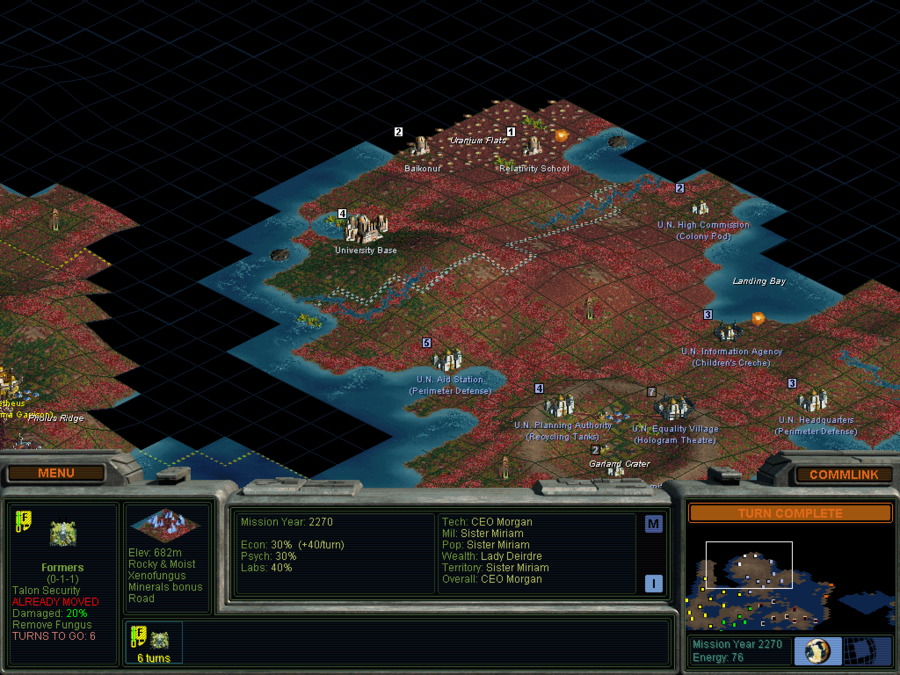

The Free State has established the new settlement of Relativity School on the Uranium Flats, further exploiting the natural wealth of that region. East Pholan and Federation settlement has split the entire Sea of Nessus in the south between their rival centers of power.
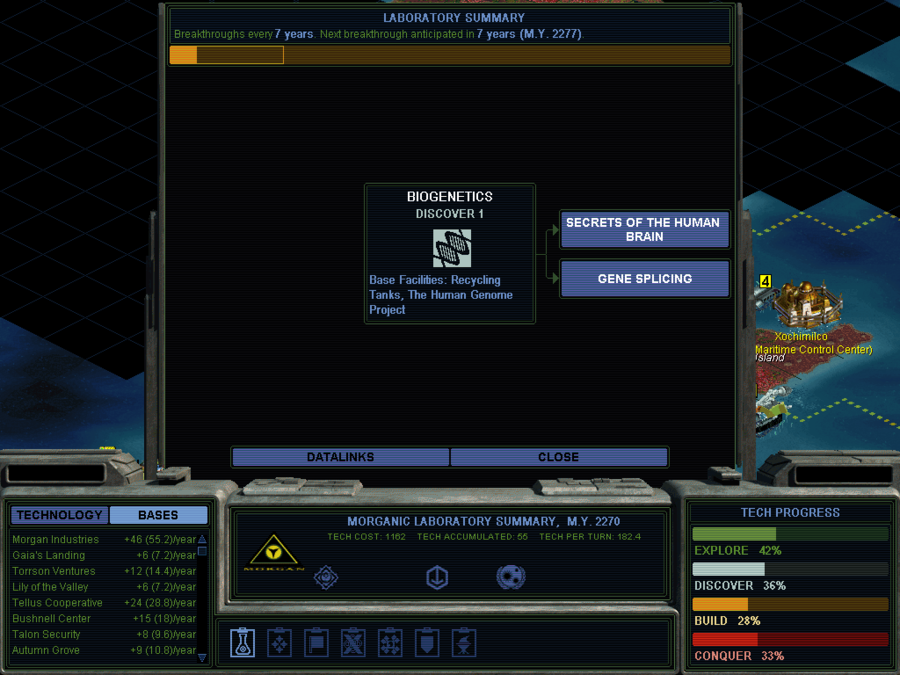
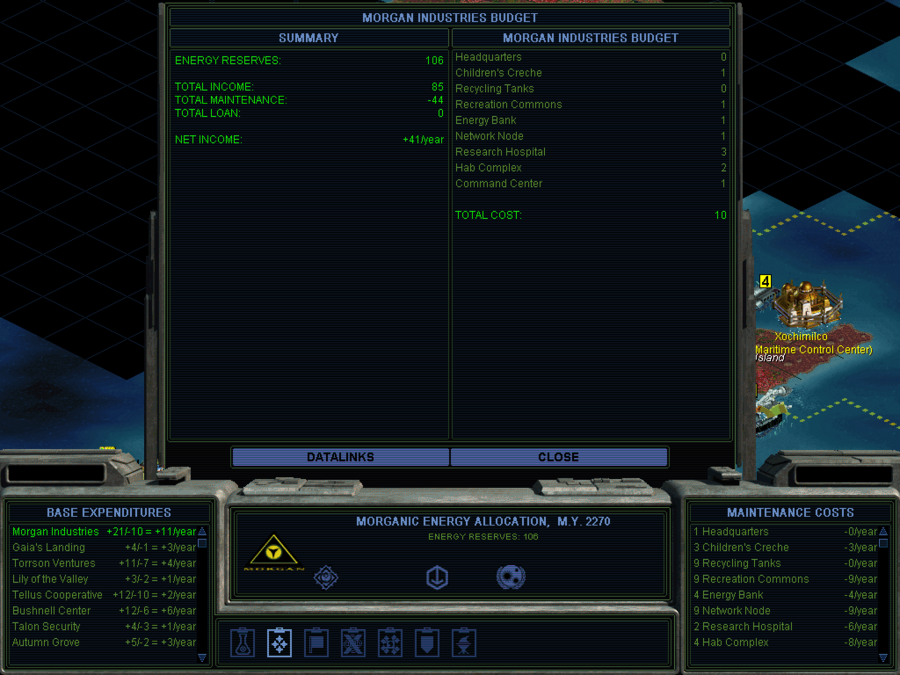
Innovation comes swiftly, although investment into durable capital has slowed somewhat in the face of growing demand for consumer goods, services, education, and healthcare. Even so, the economy is solid and healthy, and quality of life has been rising.

Xenobiologists estimate that current industrial activity in Morgan no longer presents a risk of fungal bloom, given reduced spore counts in North Pholus. Work has begun on a massive modernisation of the road and rail networks radiating out from Morgan, and construction of a greatly expanded merchant shipping fleet- perhaps, soon, transport and travel between settlements shall be considerably easier. Heavy use of synthetic fossil fuels and the strengthening economy has led to a resurgence in personal vehicles over the whole colony. Morgan's previous recession is now long over, and the settlement retains its place as the heart of the North Pholan economy. The sprawling development around Morgan has been somewhat reined in by the costs of developing new sealed habs in this heavily built-up settlement.
We have hit the new population cap of 11 (or 14 for most factions) after Hab Complexes are built. Morgan will not grow further for quite some time.
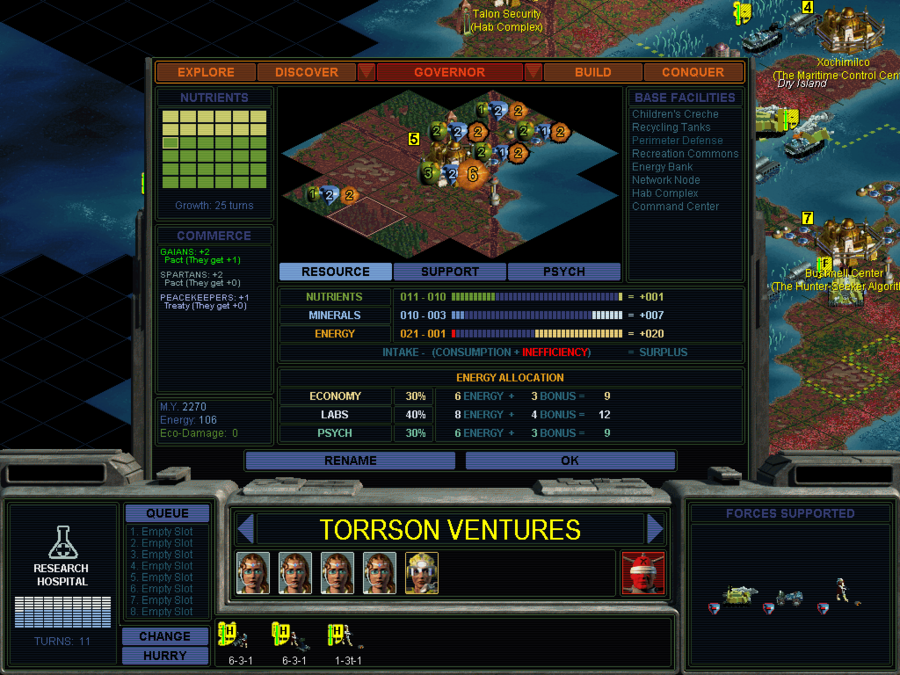
Apollo Meditech has started on the construction of a second major research hospital in Torrson, hoping to expand their business across North Pholus. The settlement is prospering, with the threat of xenofungus and of the old Gaian Dominion removed.

The Intelligence Service is mustering a new mission in Tellus, hoping to gain information on the Holy States. The growing population has begun light fishing of the interior bay, with exploitation of the tip of the peninsula cut off by xenofungal forests. Agricultural and fishing yields are not enough to allow significant growth, and agricultural concerns have been sponsoring fungal clearances in the southwest so new farms can be developed.
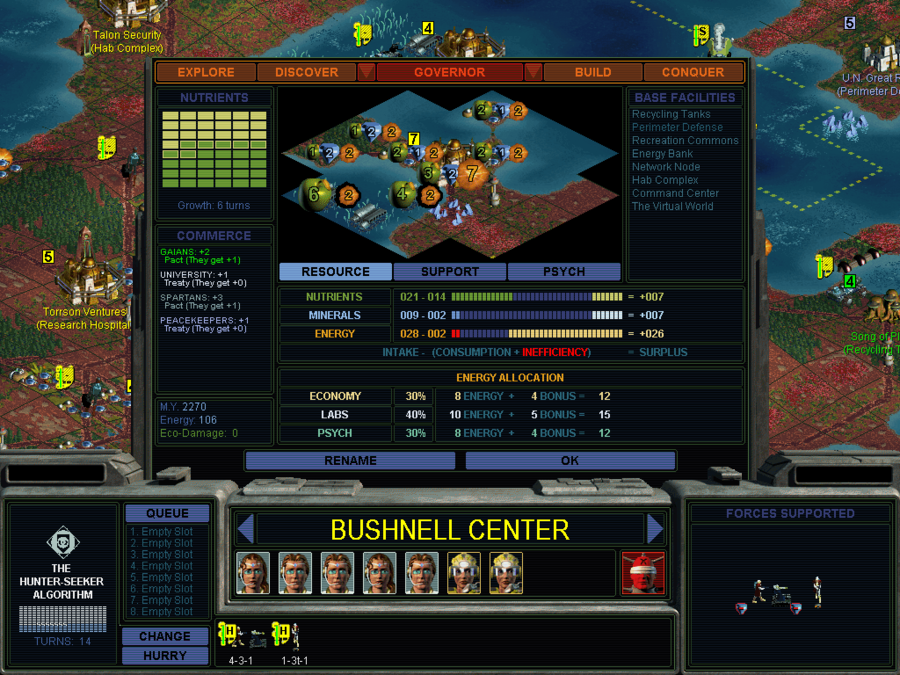
Despite the setbacks presented by the destruction of the mining complex to the south, Lovelace Computing quietly continues on its private research project. Population growth remains healthy, and Bushnell Center is expected to pass Tellus in population and overall economic output soon. Work is continuing to clear the fungal disaster and rebuild mines, but there are still years to go before this is completed.
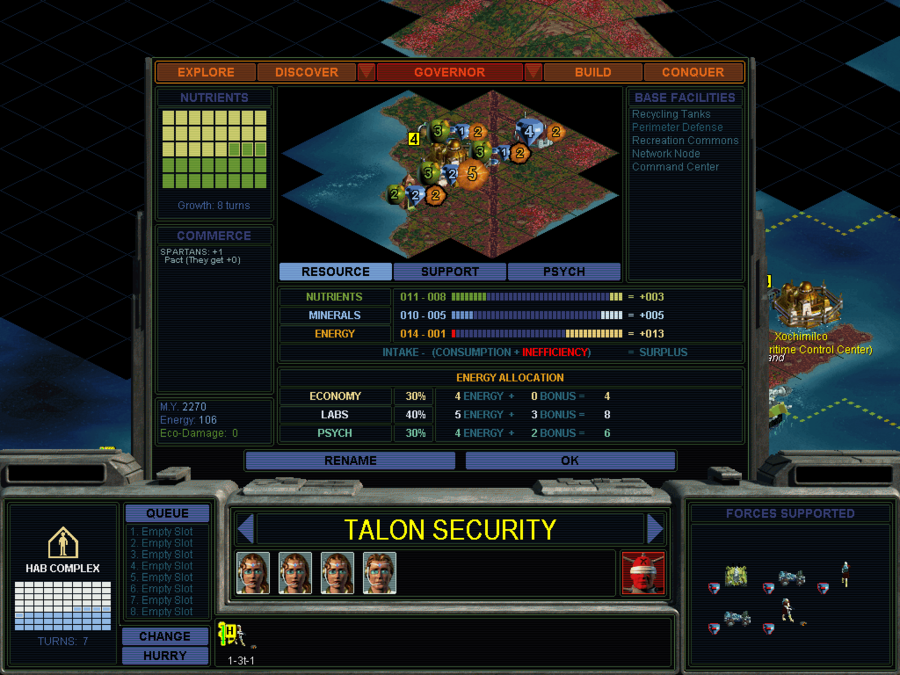
New mining techniques have helped greatly improve yields in the mines along the Great Pholus Ridge near Talon, and the settlement's industry thrives from the growing supplies of raw materials. Adoption of new industrial robotics to automate industry and better supply a growing population has begun, although it still has some time until it is completed. Half the local security force has been deployed to support Prometheus, and should return when the crisis is over.

Xochimilco is the site of a massive project in development of shipyards, support industries, and the new command center for the North Pholan Navy, such as it is. There are plans to shift a significant portion of the support industry for the settlement onto the shore as a forestry industry is established, freeing up metal productiong to be fed into the shipyards.
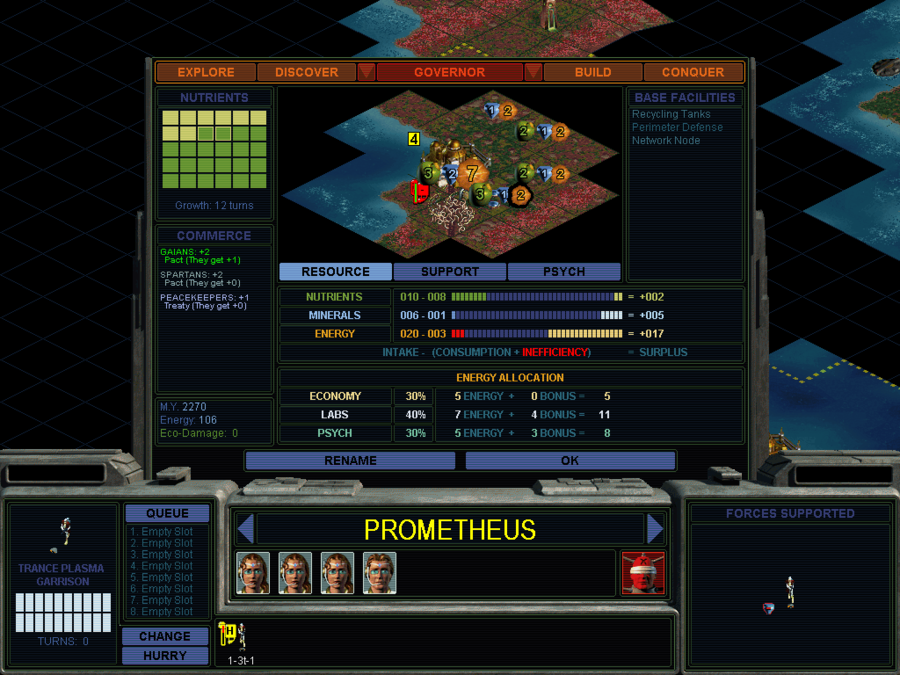
Prometheus is growing well, but its local security force is on the brink of collapse. Recruitment of new troops is an emergency priority here, hoping to save the settlement from being overrun by worms.
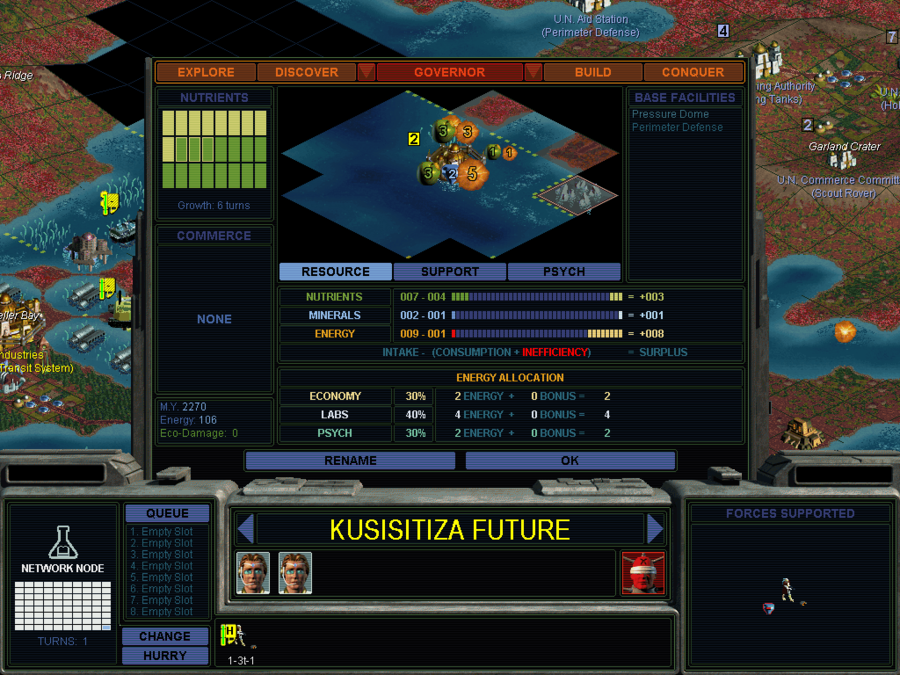
UNCC coastal patrols took control of the minerals deposits that Kusisitiza Future worked to uncover, leaving the settlement starved for industrial materials. Local industry leaders are scrambling to develop alternate plans for supply.
UN Great Refuge started working the tile immediately after I finished clearing it, and for some reason the tile isn't in our borders. Not that it is in the UNCC's borders either, but. This is very inconvenient, since I was pretty much relying on those minerals to allow the settlement to build at a reasonable pace.
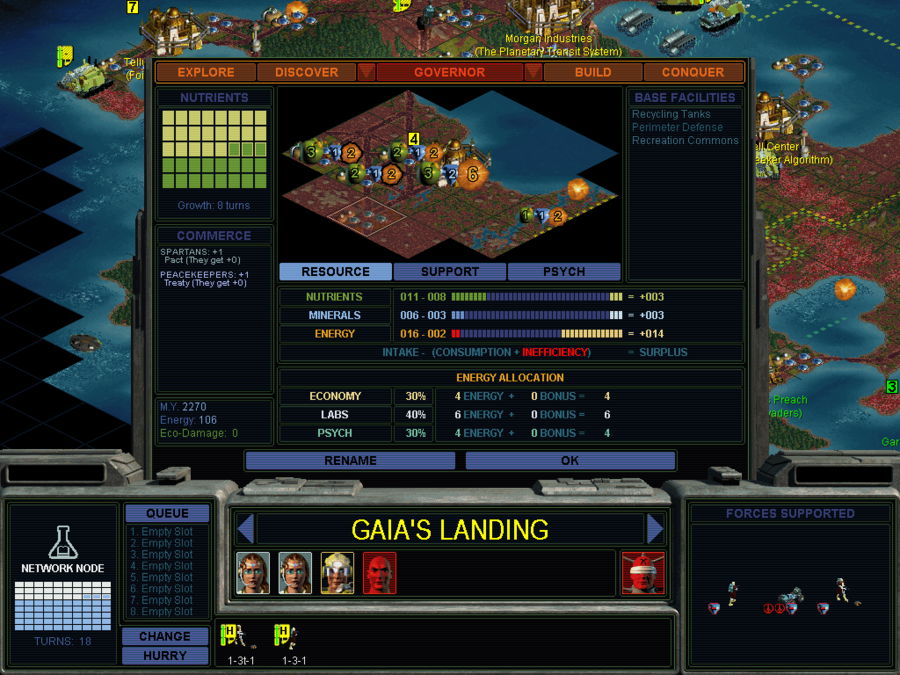
Gaia's Landing has lagged some other portions of South Pholus in establishing a high-quality network infrastructure, and protests against military costs have slowed work here. Still, these are expected to clear up quickly. The population has assimilated fairly thoroughly into the North Pholan culture, although some remnants of Gaian tradition make the settlement fairly 'exotic' by North Pholan standards.
It proves that pacifism drones will crop up when you have units in a Pactmate's territory outside of their settlements, but there are no pacifism drones for units actually stationed inside a Pactmate's territory. A little odd, but easily dealt with next turn.
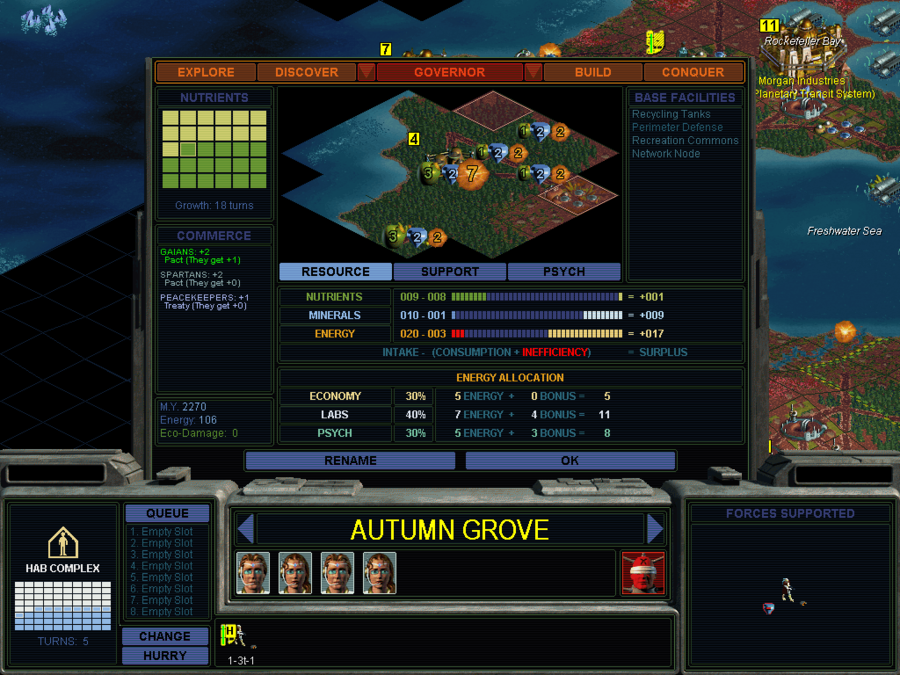
Autumn Grove has been growing into the primary industrial center of South Pholus, with local industry upgrading capital equipment in order to fuel future expansion. There is growing discussion about the establishment of the South Pholus Institute of Psychic Study in Autumn Grove, with researchers seeking to develop the reliable ability to glean information from human minds.
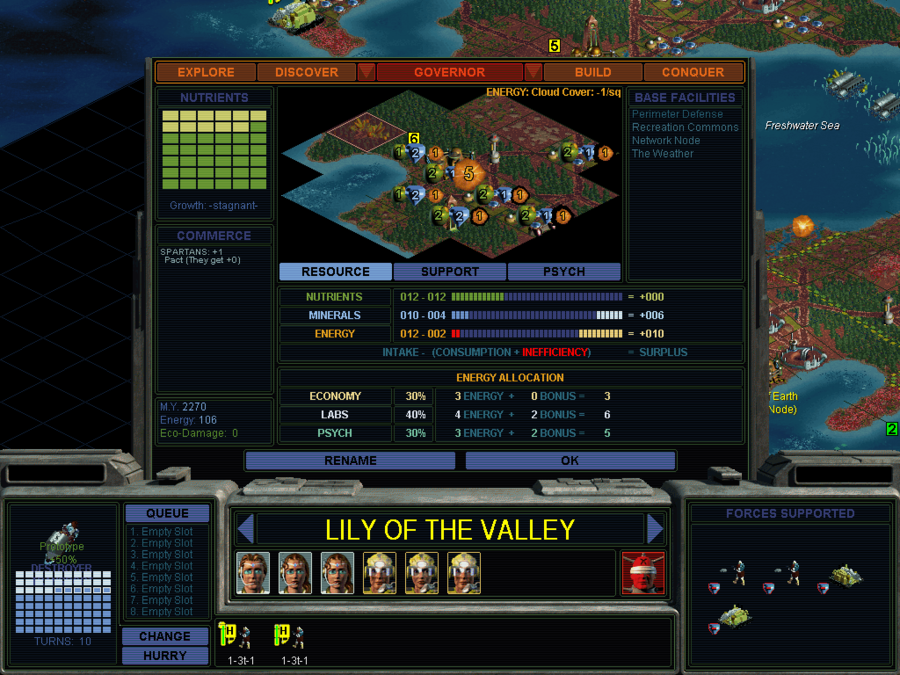
Despite the economic slump in Lily of the Valley, quality of life and productivity remain generally good. The South Pholan government is sponsoring a mission of exploration on a newly-built ship, the Adventure, equipped with its own armor and light defensive weaponry.
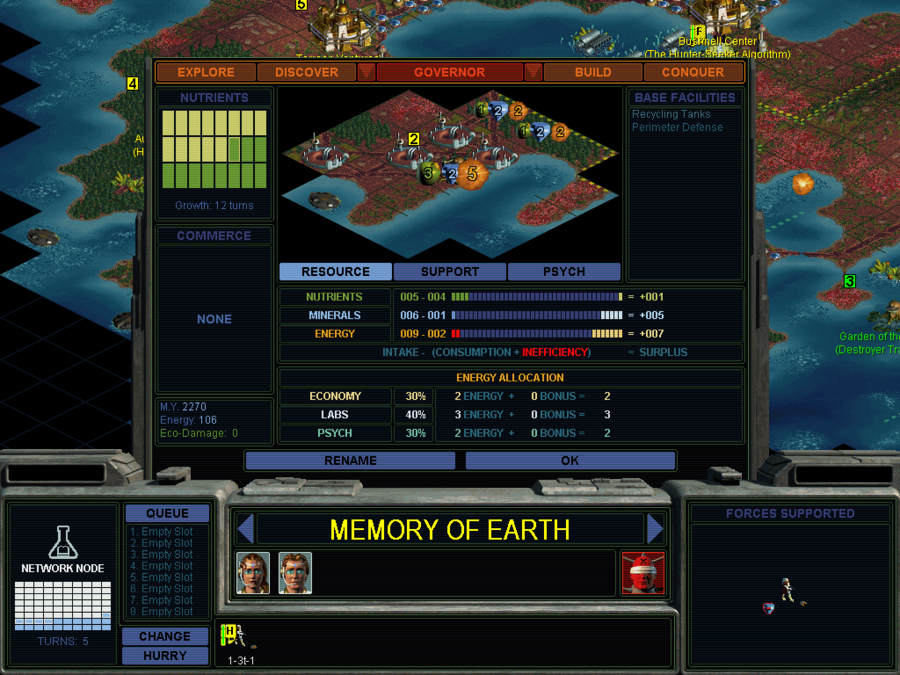
Memory of Earth remains a backwater with a strong forestry industry, although work to establish a high-quality network infrastructure is under way here. Perhaps eventually Memory of Earth will grow past its modest beginnings, but there is little evidence that it shall be soon.
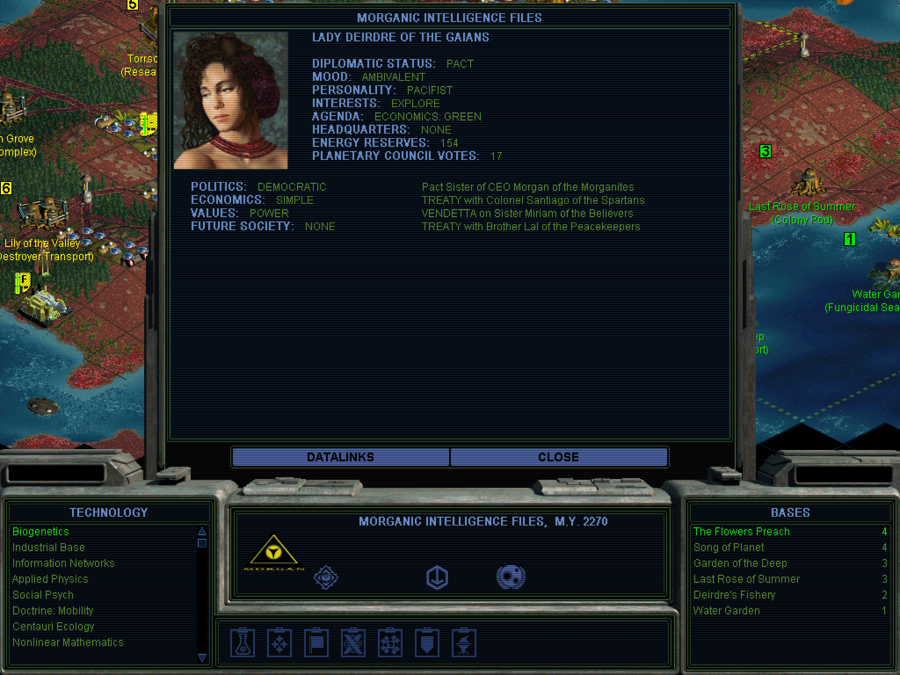
The Republic of East Pholus has joined the North Pholan 'war' on the Holy States, although East Pholus is under little threat thus far, buffered from the Holy States by North Pholus, South Pholus, and the Spartan Federation. East Pholus is, perhaps, the single most important trade partner for North Pholus, and benefits from the extensive commerce. Although East Pholus has only about three-fifths the population of the Spartan Federation, the East Pholan economy essentially matches the Spartan economy in size.
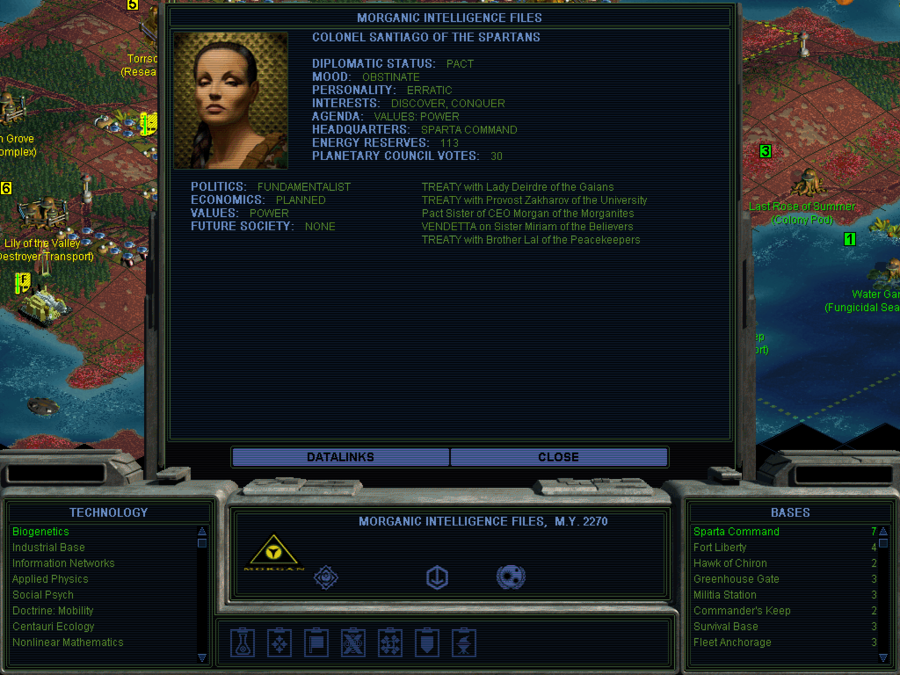
Tensions with the Spartan Federation have moderated, the Spartans remaining focused on the threat of the Holy States. The economy is functional, but distinctly weaker than that of the UNCC or East Pholus.

The UNCC remains on friendly terms, but sees little need to seek alliance with North Pholus. Despite the cost of the UNCC military and social spending apparatus, the UNCC has, easily, the second-strongest economy on Chiron, and has developed powerful innovation alongside a rich heritage of art, culture, and education. The UNCC, unique amongst known colonies, has managed to establish reasonably friendly relations and commerce with the Holy States.

The Planetary University Free State is steadily growing and solidifying their hold on Northwestern Hercules. Although still tiny compared to the great powers of Chiron, the Free State's growing power has helped render their colony more secure.
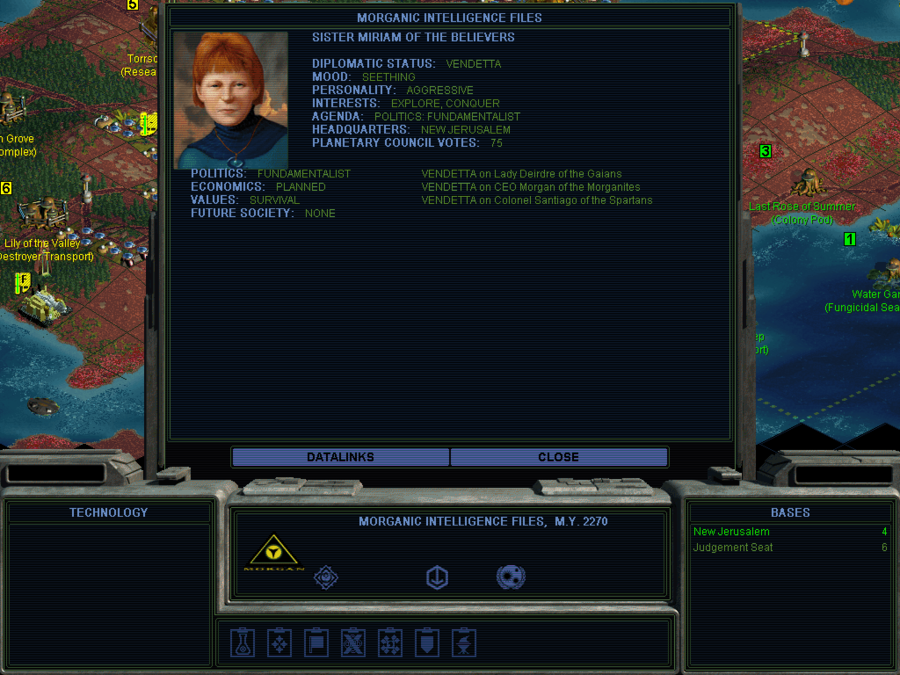
The Holy States have adopted a 'commanding heights' socialist mixed economy, with many major industries owned by the state, while smaller private service businesses or light industries operate under rigorous state regulation. The growing centralisation of religion, government, and economics has washed away the earlier 'frontier' character that prevailed in the Lord's Alliance, replacing it with a society tightly bound together by common beliefs, common authorities, and common economic plans.
The threat of sudden xenofungal blooms has shown itself, but has nearly as swiftly subsided for the moment, while intercolonial commerce continues to grow and bring prosperity across the explored portions of Chiron. Though the war with the Holy States continues, there is yet to be major fighting. Hopefully this state of relative peace shall endure.